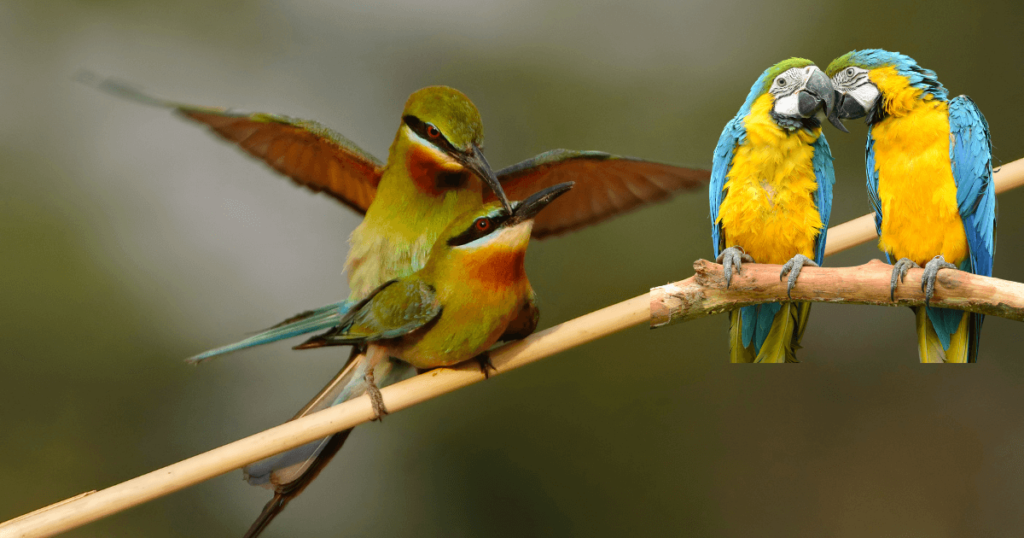Understanding the Mechanisms of Avian Reproduction
The interesting and complex reproductive mechanisms of birds are essential to the survival of bird species. For bird breeders, environmentalists, and avian lovers alike, understanding these processes is crucial. The stages and mechanisms involved in promoting avian reproductive health will be examined as we dig into the fascinating world of avian reproductive biology in this part.

Table of Contents
The Avian Reproductive System: Anatomy and Function
The interior and external structures of the avian reproductive system have been specially designed to satisfy the specialized needs of avian reproduction. The ovary, which generates ova (eggs), is one of the essential parts. Birds only have one functional ovary, which is located on the left side of the body, in contrast to mammals. Birds can maintain a reduced weight because to this adaptation, which helps with flight.
Another essential element of the avian reproductive system, the oviduct is in charge of egg creation, fertilization, and development. It has the infundibulum, magnum, isthmus, uterus, and vagina as well as other portions. When it comes to the development and production of eggs, each area has a specific function.
Avian Reproductive Hormones: Orchestrators of the Process
The regulation of avian reproductive processes is greatly influenced by hormones. Estrogen and progesterone, the two main hormones involved, are in charge of starting and maintaining the reproductive cycle. Progesterone primes the uterus for the production of the eggshell while estrogen promotes the development of reproductive behaviors and organs.
Luteinizing hormone (LH) is a crucial hormone in the reproduction of birds. It causes ovulation, which is when a mature egg is released from the ovary. The ovarian follicles, which house the developing ova, are stimulated to grow by the hormone called folicle-stimulating hormone (FSH).
Avian Reproductive Processes: A Complex Journey
Male and female interactions during courtship are the beginning of the process of avian reproduction. Birds use courtship rituals to form close pair connections and judge each other’s suitability as mates. These activities frequently include colorful feather displays, complex songs, and elaborate dances.
The female bird’s reproductive system undergoes a series of amazing changes once a couple has established a relationship. The ovary, the body’s main reproductive organ, begins to develop and produce eggs. In the majority of bird species, only the left ovary is functioning; the right ovary is still rudimentary.
Hormones play a complex role in controlling the egg-producing process. Progesterone primes the uterus for the production of the eggshell while estrogen promotes the development of reproductive behaviors and organs. LH, or luteinizing hormone
The developed egg is subsequently released from the female bird’s ovary and is collected by the infundibulum, the oviduct’s initial segment. If mating has taken place, the infundibulum is in charge of catching the egg and providing a location for fertilization. The egg then undergoes different alterations and receives layers of albumen and shell membranes as it travels through the magnum, isthmus, uterus, and vagina.
Promoting Optimal Reproductive Health in Birds
Promoting ideal reproductive health is crucial for the survival and reproductive success of bird species. Supporting bird reproduction requires proper diet, a stimulating habitat, and veterinary care. This section will examine the main elements that support the health of avian reproductive systems.
Balanced Nutrition: Fueling the Reproductive Engine
For birds to be healthy generally and to reproduce successfully, they need to eat a balanced diet. It offers the nutrients required for the growth of wholesome eggs and the healthy operation of reproductive organs. It’s crucial to eat a diet full of high-quality proteins, vitamins, minerals, and important fatty acids.
It is significant to remember that different bird species have different dietary needs. Finches, which consume seeds, have distinct nutritional requirements from hummingbirds, which consume nectar, or predatory raptors. It’s essential to feed animals a diet that closely resembles their natural food sources to support their reproductive health.
Environmental Enrichment: Stimulating Natural Behaviors
The physical and mental health of birds depends on providing them with a rich habitat. The stimulation of natural activities, like as courting, nesting, and child rearing, is accomplished via environmental enrichment. It may entail offering perches, nesting supplies, toys, and chances for social interaction.
The health of bird reproduction can benefit by mimicking natural temperature and light cycles. To encourage breeding behaviors and maintain their reproductive cycles, birds need certain photoperiods. Their natural impulses are encouraged when an appropriate setting that matches their habitat is provided.
Veterinary Care: Guardians of Avian Reproductive Health
For avian reproductive health to remain at its best, routine veterinary care is essential. The diagnosis and treatment of reproductive problems in birds is a specialty of avian veterinarians. To find any potential issues, they might conduct extensive health screenings, hormonal tests, and reproductive assessments.
In addition to doing fertility tests before breeding, avian veterinarians are quite important. They may monitor egg production, offer advice on proper breeding techniques, and deal with any potential reproductive issues. Effective breeding and healthy progeny are substantially more likely with prompt veterinary assistance.
Common Reproductive Health Issues in Avian Species
Numerous elements, such as genetic predispositions, environmental stressors, and infectious diseases, might affect the reproductive health of avian species. We will look at a few of the typical problems with bird species’ reproductive health in this part..
Egg Binding: A Delicate Situation
When a female bird is unable to remove an egg from her reproductive system, this condition is known as egg binding. The illness is potentially fatal and necessitates emergency veterinarian care. Egg binding can be brought on by a number of things, such as a calcium deficit, poor muscle tone, or improper egg development.
Lethargy, fluffed feathers, straining, and an inability to pass feces are signs of egg binding. Egg binding can cause egg yolk peritonitis, a severe infection that can be fatal, if it is not treated. To address the underlying issue and help with the egg removal safely, prompt veterinary assistance is required.
Reproductive Tumors: Unwanted Growths
Reproductive tumors can affect both male and female birds and can arise in various reproductive organs. Ovarian tumors, testicular tumors, and tumors of the cloaca are among the common types. These tumors can interfere with normal reproductive processes, leading to infertility or other complications.
Symptoms of reproductive tumors can vary depending on their location and size. They may include abdominal swelling, weight loss, reduced activity, or changes in behavior. Avian veterinarians can perform diagnostic tests, such as ultrasounds or X-rays, to identify the presence of tumors and develop appropriate treatment plans.
Infertility: The Struggle to Conceive
Infertility is a common reproductive issue faced by avian species. It can be caused by various factors, including poor nutrition, hormonal imbalances, age-related decline in fertility, or genetic abnormalities. Both males and females can contribute to infertility, making a comprehensive evaluation necessary.
Avian veterinarians can perform fertility assessments, including hormonal testing, semen analysis, and egg quality evaluations. Based on the findings, they can provide recommendations to enhance fertility, such as dietary modifications, hormonal treatments, or assisted reproductive techniques.
Promoting Avian Reproductive Health: A Vital Responsibility
To ensure optimal Avian Reproductive Health, several factors must be considered. Providing a balanced and nutritious diet is crucial, as it directly impacts the overall health and reproductive success of birds. A diet rich in essential vitamins, minerals, proteins, and fats supports the development of healthy eggs and ensures proper functioning of the reproductive system.
Creating an enriched environment is equally important. Birds should have access to appropriate nesting materials, perches, and space for courtship displays and exercise. Environmental enrichment stimulates natural behaviors, reduces stress, and fosters successful breeding outcomes.
Regular veterinary care is essential for monitoring avian reproductive health. Avian veterinarians play a vital role in conducting health examinations, providing pre-breeding evaluations, and addressing any potential reproductive issues. They can also offer advice on breeding strategies, hormone therapy if needed, and identify and treat reproductive health problems that may arise.
Common Reproductive Health Issues in Avian Species: Understanding the Challenges
Avian reproductive health can be impacted by various factors, leading to reproductive health issues. These issues can include egg binding, reproductive tumors, infertility, and hormonal imbalances.
Egg binding occurs when a female bird is unable to expel an egg from her reproductive tract. It is a critical condition that requires immediate veterinary attention. Causes of egg binding can include calcium deficiency, inadequate muscle tone, or abnormal egg formation.
Reproductive tumors can affect both male and female birds, and they can arise in various reproductive organs. These tumors can interfere with normal reproductive processes and may require surgical intervention or other treatment options.
Infertility is a common issue faced by avian species. It can be caused by poor nutrition, hormonal imbalances, age-related decline in fertility, or genetic abnormalities. Avian veterinarians can perform fertility assessments and recommend appropriate treatments or interventions.
FAQs about Avian Reproductive Health
- Q: How often do birds lay eggs?
- A: The frequency of egg-laying varies among bird species. Some birds lay eggs daily, while others lay eggs intermittently or only during specific seasons.
- Q: Do all birds build nests to lay their eggs?
- A: No, not all birds build nests. Some birds lay their eggs on the ground or in tree cavities, while others construct intricate nests using twigs, leaves, and other materials.
- Q: Can birds lay unfertilized eggs?
- A: Yes, female birds can lay unfertilized eggs. These eggs do not contain embryos and are often reabsorbed or discarded by the bird.
- Q: What is the role of male birds in incubating eggs?
- A: In some bird species, both males and females take turns incubating the eggs. In others, only the female is responsible for incubation, while the male provides food and protects the nest.
- Q: How long does it take for bird eggs to hatch?
- A: The incubation period varies depending on the bird species. It can range from a few days to several weeks. Larger birds generally have longer incubation periods.
- Q: Can birds lay eggs without mating?
- A: Yes, some birds, such as certain species of parrots, can lay eggs without mating. This behavior is known as parthenogenesis.
Conclusion
Avian reproductive health is a complex and captivating field of study. By understanding the intricacies of avian reproductive processes, promoting optimal reproductive health, and addressing common reproductive health issues, we can contribute to the well-being and conservation of avian species. Through balanced nutrition, environmental enrichment, and timely veterinary care, we can nurture the next generation of birds, ensuring their continued presence in our diverse natural world.

